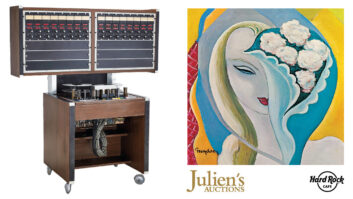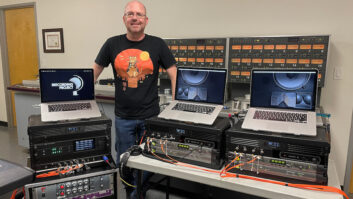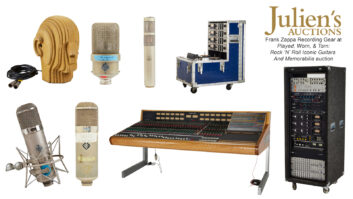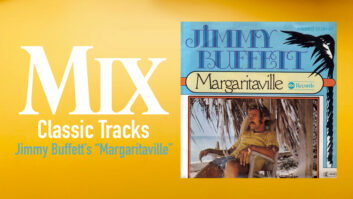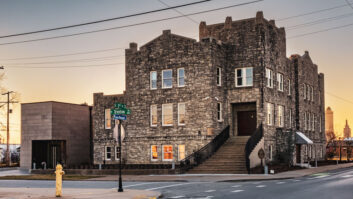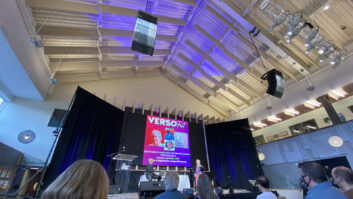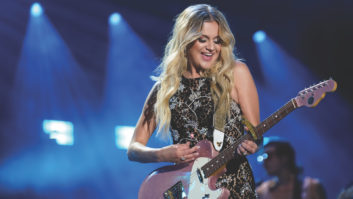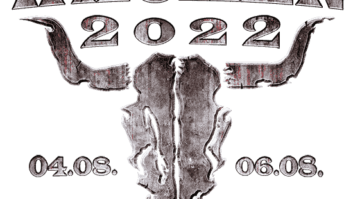From 1989 until 1994, Eric Clapton’s annual two-week residency at London’s Royal Albert Hall became something of a tradition. Though the lineup of guest musicians varied over the years, the quality of the show’s sound production steadily improved, and, despite the room’s difficult acoustics (the RAH was designed in the late 19th century and was intended only for classical music concerts, for which many would claim it is poorly suited), Clapton’s audio team consistently managed to produce finely tuned sound balances. (See Mix’s January 1992 issue for a related article on the recording of Clapton’s 24 Nights album.)
Clapton’s FOH engineer for many of the annual RAH shows and concurrent tours was Robert Collins, an independent engineer whose client list also includes The Who. When it came time to design the sound system for Clapton’s 2001 tour, which kicked off with six nights at the RAH on February 3, Collins opted to move away from the traditional tools and methods that had made the “Clapton at the RAH” shows such a success. Instead, he placed his reputation on the line by using EAW’s new (and previously untried) KF900 Series P.A. Not only was the Clapton tour the first in Europe to be equipped with the recently introduced KF900 “Phased PointSource Technology” system (supplied by UK-based Concert Sound), Collins compounded his bravery by choosing to take Yamaha’s long-awaited PM-1D digital mixing console on its debut European tour.
Known for his dislike of unnecessary technical frills, Collins was keen to introduce some changes into his mixing environment, but not if it meant having to discard a lifetime’s touring experience. “I looked long and hard at the various new boards that were around,” he recalls. “When it came to the Yamaha, I thought, ‘Maybe an old bastard like me could use this.’ The jury’s still out, but I haven’t had any problems getting my head ’round the basics. Of course, it can do so much — it just depends on how far you want to go. At the moment, I’m trying to make it work the way I like to, in very much the same way as a traditional analog console.” Though this may not be the way that the PM-1D’s designers intended it to be used, Collins notes it is he who has to face the audience — and the band — every night, not the console designers.
MODULAR DESIGN AIDS MIXER CONFIGURATION
The PM-1D is based on a modular concept, providing for an almost limitless variety of console configurations, though all share the same 48-channel control surface. Inputs and outputs may be analog or digital, and digital formats include both the AES/EBU professional standard and S/PDIF/TDIF semi-pro options. A range of 3U and 4U input/output racks are available, each of which can handle up to 32 separate feeds. Auxiliary mixes, matrix sends and insert send/returns only appear as real connectors if required, saving rackspace and money by eliminating unnecessary hardware. Every adjustable parameter, including the analog gain control for the input A/D converters, is automated as a series of snapshots. While dynamic (i.e., continuous) automation is not yet available, it should be pointed out that the Concert Sound PM-1D started the Clapton tour equipped with Version 1.0 software.
The console’s audio connections and converters, which are located onstage, are configured to the tour’s exact requirements — 48 analog inputs from the stage, plus a couple of stereo line inputs for pre-show playback. To enable the PM-1D to cope with the enormous dynamic range encountered in a live environment, the console’s A/D converters are 28-bit — configured by cascading two 24-bit devices — so that even when a signal is at a low level, resolution is high. Headroom, according to Yamaha, is exceptional.
Inputs — whether analog or digital — are linked digitally to the console’s “engine,” a powerful DSP rack that performs all of the mixing, equalization, dynamics and delay functions for the system. For this tour, this is positioned in the FOH enclosure, but would normally be onstage to cut down on the cabling from the input racks.
The control surface and engine are connected by a 32-pair digital audio cable (used for passing the FOH engineer’s local monitoring signals and other local audio feeds) and a pair of coaxial control cables. Other connections include a 48-track Mackie hard disk recorder, which is fed from each channel’s direct output as a pre-fade digital signal. Collins requested the Mackie unit as part of the team’s rehearsal rider, and it has stayed for the tour. “I wanted a multitrack for rehearsals to let me hear what I was doing,” he explains. “I would record tracks without any EQ or processing, so that I could replay them later and go over the mix.”
Despite the fact that the PM-1D offers a sophisticated onboard package of dynamic processors and effects devices, Collins was keen to use some of his tried-and-trusted outboard gear. These include a number of dbx 160S compressor/limiters, which he has inserted into key channels via AD/DA cards in the PM-1D racks. Effects, which include an Eventide DSP7000, TC Electronic M5000 and D-TWO, plus a clutch of Lexicon reverbs, were originally fed from auxiliaries and returned to inputs in the analog domain. But, at Yamaha’s suggestion, these were rewired to preserve the all-digital signal path. “I was impressed with the clarity and cleanness of the effects when we connected them digitally,” noted Collins. “In fact, when we ran instruments through the board for the first time, they were so clean it frightened me!”
FLIPPING FADER BANKS
Collins, like most engineers, is accustomed to having his mixing console laid out in a certain manner and had to think carefully about how to condense a large number of inputs onto the PM-1D’s comparatively small control area. The control surface includes four “banks” of 12 channels each, with a second layer of inputs hidden below the first, for a total possible input count of 96. Collins assigned his most important inputs (bass, acoustic bass, five guitar channels and vocals) to channels 13 through 24, immediately to the left of the console’s output section. To the right, occupying channels 37 to 48, he assigned the percussion instruments; being wildly dynamic, these needed more attention. Above these key channels, Collins arranged the remaining 24 inputs, with the drum kit (kick, snare top and bottom, splash, hi-hat and ride cymbals, two overheads and four toms) as one bank of 12. Miscellaneous feeds and effects returns were assigned to the last bank.
“After having had this board for a couple of weeks — mainly in rehearsal for this tour — flipping between banks of faders becomes second nature,” says Collins, and watching him flip instantly between banks, bringing troublesome channels to his fingertips in an instant, dispelled any doubts about the console’s intuitive design. “This is the beauty of this board — having 48 real faders,” Collins adds. “If Yamaha had given me something with six faders and forced me to page through everything, I wouldn’t even have put it in my bedroom!”
As is common with large and complicated P.A. rigs, the console is used to produce multiple mixes, and at the RAH, the PM-1D generated a main stereo feed and three auxiliary sends. One aux mix was used to drive a number of diminutive EAW JF80 frontfill speakers, essential for that section of the audience sitting on-axis with the backline of guitar amps. A second aux mix fed left and right ground stacked EAW KF750s, which were used to cover the audience located under the main array, while a third aux mix fed the “choir stalls” at the Royal Albert Hall, additional seating to the side and behind the thrust stage. “Up at the back, the audience is hearing a lot of the monitor sound, so we put a lot of vocals and the acoustic guitars into the rear mix,” notes Collins. “One of the great things about the Yamaha board is that you’ll never run out of outputs!”
The main stereo feed would normally be fed to a left-right pair of flown loudspeaker arrays, but Collins and Concert Sound chose to use a single central cluster to deal with the circular RAH. Rusty King, formerly of Spectrum Sound in Nashville, takes care of the mighty rig. “We’ve zoned the center cluster to provide a stereo mix for the front and mono round at the sides, where stereo wouldn’t make any sense,” he explains. “Rather than dealing with the system as a number of loudspeaker cabinets, it’s actually divided into ‘cells.’ Each of these is a single horn or pair of horns, and by changing the level and delay of the signal that we give to each of them, we can actually change the pattern of the coverage that the whole system gives.”
At the RAH, three different cabinet types were combined to form the array; the KF930 long-throw, low-frequency enclosure (which has two independent 15-inch loaded horns), the KF920 long-throw midrange cabinet (fitted with a trio of 10-inch drivers, again horn-loaded) and a number of KF913 medium-throw/downfill HF boxes. These latter feature three 2-inch compression drivers mounted on EAW’s SimplePhase horns, each of which is angled differently to produce a spreading coverage pattern. By flying one row of KF913s upside down, the team was able to cover the tall auditorium (which has no less than seven levels of seating) from a single vertically hung array.
DSP OPTIMIZES SYSTEM
The EAW system is heavily dependent on DSP to create the required system coverage, and no less than 10 BSS Soundweb digital matrix processors fed 33 separate audio channels to the system’s LAB Gruppen power amps. As well as providing the required delay and level correction, the Soundwebs are also used for equalization, bandpass filtering for each driver type and dynamic control to ensure that the system is working optimally. Collins, faced with mastering an unfamiliar console, was happy to hand the system over to King. “It’s quite amazing how much control you have over this system — whatever happened to the simple crossover with four knobs?” comments Collins. “The only thing you have to be careful about is that you don’t change anything while you’re doing something else — when I’m listening to the band, it’s ‘hands off!”
Concert Sound’s Tim Boyle has been working in the European live sound industry since its early days. “We’ve always had a close relationship with EAW and with Spectrum, who have been using the KF900 system for a while,” says Boyle. “Twenty-five years ago, it was the normal thing to do to stack horns in columns — we knew how to couple more than one speaker to ‘throw’ a long way. Somewhere along the line, someone had the bright idea of putting all the elements into one cabinet, but for some applications, it doesn’t work as well. What EAW has done is in some ways a big step forward, but in others it’s like looking back in time. The advantage now is that with the technology we have at our fingertips, the result is much more coherent and completely controllable.”
For Eric Clapton’s other European dates, which included bigger arena shows in the UK, a more conventional pair of arrays was used. In the case of Manchester’s 15,000-capacity MENA venue, the KF900 rig was used without delay speakers, a rare opportunity to save time and money on a tour of this scale. Interestingly, even at these larger venues, the Concert Sound crew did not need to call upon EAW’s ultra-long-throw design, the KF910. (This HF cabinet contains a total of five 2-inch drivers on long horns, arrayed in a straight line and using line array principles to increase the system high-frequency coverage to over 700 feet.)
A dozen EAW SB1000s provided sub-bass (always an issue on tour, especially with acoustic instruments playing a major part in the music). The dual 18-inch SB1000 has become extremely popular in Europe where its tight low-end control and general musicality are greatly appreciated. For the larger arena shows, the SB1000 contingent was doubled to 24.
TRADITIONAL MONITOR SYSTEM
Faced with so much new technology, it almost comes as a relief to find that Clapton’s monitor system is very traditional and has not varied much in the last few years. A Midas XL4, supplemented by a 24-channel XL3, handles the mixing, while Concert Sound’s wedge monitors provide the band with their every musical wish.
Taking a new piece of equipment on the road is never an easy decision — and it is made many times harder when the equipment in question is critical to the show. Add the fact that Robert Collins has spent a long time developing a relationship of trust with Clapton and his band, and the temptation to play it safe must be very strong indeed. However, given the right level of manufacturer backup (and, at times, there were more technical people from EAW and Yamaha on the tour than actual sound crew), little problems should never get the chance to develop into major ones. The live sound industry has long been criticised for using technology that lags behind the lighting, set design, video and sometimes even catering departments — but according to Robert Collins, it’s the engineers themselves who are to blame. “The bottom line is that, if it all goes wrong, give me a basic desk and a normal P.A. and we’ll have a good gig tomorrow. They say you can’t teach an old dog new tricks, but learning to work with this level of technology is only a minor problem for us old guys. I might go back to an old Midas after this tour — or I might become a convert. If you don’t try, you’ll never know, will you?”
Eric Clapton’s 2001 tour takes him to 25 European cities before a rare performance in Moscow. Following a short break, the tour then heads for North America and will wind up in the Pacific Rim toward the end of the year.
Mike Mann is a freelance writer living in England.
